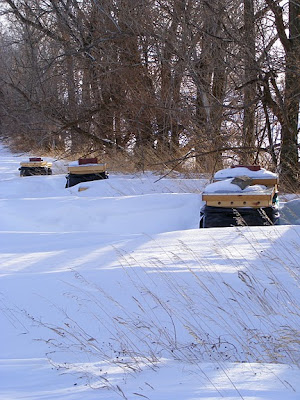The survival of a honey bee colony over the winter depends largely upon the way the beekeeper sets up the hive in the fall. The first requirement for winter-time survival is that the bee hive must have adequate ventilation. Honey bees maintain a warm hive throughout the winter. Whenever the bees have brood present, they maintain a temperature in the brood nest of 95 degrees Fahrenheit.
The bees can withstand a cooler temperature than their developing brood, so they will only warm their cluster of bees to about 70 degrees when they stop rearing brood in the winter. This is equivalent to our lowering the setting on our home thermostat in the winter to save energy. The honey bees’ respiration produces moisture inside the hive. With a warm, damp atmosphere inside the hive and cold winter temperatures outside, condensation occurs inside the hive. The effect is similar to that which occurs on the outside of a cold glass of iced tea on a humid summer’s day here in the Delta. Water drips profusely down the glass. Water from condensation dripping into the brood nest bees kills bees. Tilting the hive forward in the winter keeps the water from falling onto the bees. It is most important to provide ventilation to prevent condensation from occurring. Leaving screened bottom boards uncovered provides good ventilation for the hive. A vent port in the hive’s inner cover provides air flow through the top of the hive. Surprisingly, protecting from cold temperatures is not a requirement for winter-time hive set-up.
The second requirement for the bees to survive the winter is that they must have adequate stores of honey, and it must be located where the bees can access it. The honey should be above the cluster of bees. The bees consume the honey above their cluster and then move upward into the empty cells. Experience tells beekeepers how much honey the hive needs for the winter: in the Arkansas Delta, about 60 pounds.
The bees can withstand a cooler temperature than their developing brood, so they will only warm their cluster of bees to about 70 degrees when they stop rearing brood in the winter. This is equivalent to our lowering the setting on our home thermostat in the winter to save energy. The honey bees’ respiration produces moisture inside the hive. With a warm, damp atmosphere inside the hive and cold winter temperatures outside, condensation occurs inside the hive. The effect is similar to that which occurs on the outside of a cold glass of iced tea on a humid summer’s day here in the Delta. Water drips profusely down the glass. Water from condensation dripping into the brood nest bees kills bees. Tilting the hive forward in the winter keeps the water from falling onto the bees. It is most important to provide ventilation to prevent condensation from occurring. Leaving screened bottom boards uncovered provides good ventilation for the hive. A vent port in the hive’s inner cover provides air flow through the top of the hive. Surprisingly, protecting from cold temperatures is not a requirement for winter-time hive set-up.
The second requirement for the bees to survive the winter is that they must have adequate stores of honey, and it must be located where the bees can access it. The honey should be above the cluster of bees. The bees consume the honey above their cluster and then move upward into the empty cells. Experience tells beekeepers how much honey the hive needs for the winter: in the Arkansas Delta, about 60 pounds.

No comments:
Post a Comment